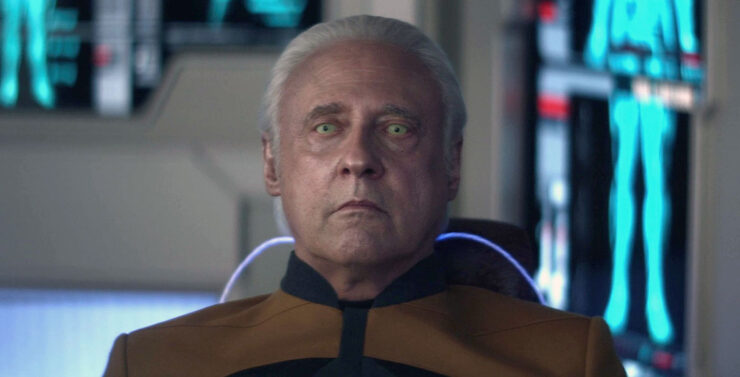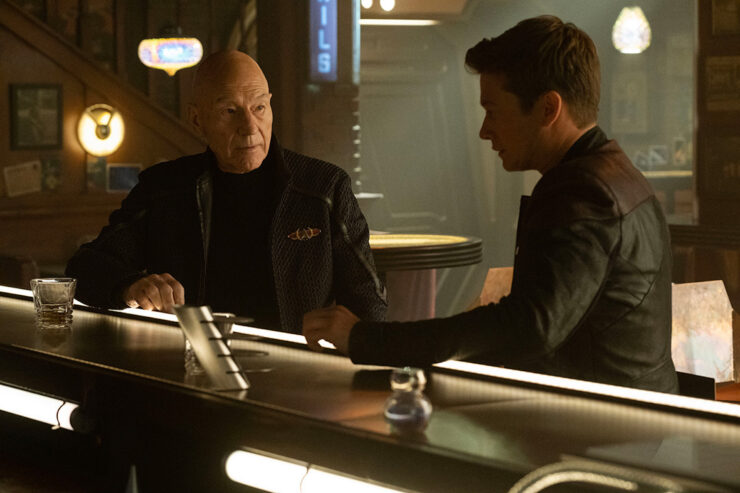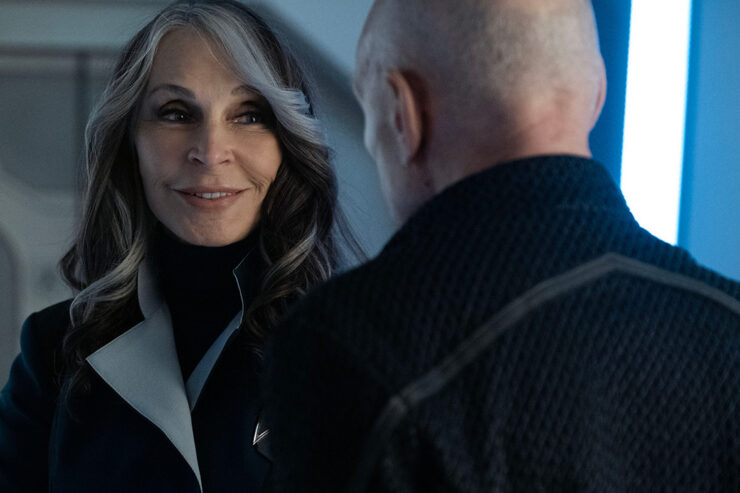When it was announced that Picard season three would be a reunion of the TNG “big seven,” one of the many speculations about it was who, exactly, Brent Spiner would play. His main character of Data sacrificed his life in Nemesis and then went from mostly dead to all dead in Picard’s “Et in Arcadia Ego, Part 2.” But Spiner has played five other characters in Trek: the androids Lore (TNG’s “Datalore,” “Brothers,” the “Descent” two-parter) and B-4 (Nemesis), Noonian Soong (TNG’s “Brothers,” “Birthright I,” “Inheritance”), Soong’s son Altan (Picard’s “Et in Arcadia Ego” two-parter), and Soong’s ancestors Arik (Enterprise’s “Borderland,” “Cold Station 12,” “The Augments”) and Adam (Picard’s “Fly Me to the Moon,” “Two of One,” “Mercy,” “Hide and Seek,” “Farewell”).
We get the answer this week, and it’s not what I expected at all…
Spiner’s appearance in this episode also means that, coupled with the arrival of LeVar Burton’s Commodore Geordi La Forge, this episode is the first time all of the big seven are in the same episode (though we have yet to get them all together in the same room).
More on Burton in a bit. In Spiner’s case, the answer to the question of who he would play turns out to be more complicated than expected. Spiner is actually playing several of the characters I listed above, plus at least one more…
As it turns out, and as one could guess from the reference to the sophisticated AI Krinn mentioned last week, the complex AI that guards Daystrom is Data—sort of. Riker, Worf, and Musiker beam over to Daystrom, using a workaround of the transport inhibitors that Ro left for them. But they only have an hour between physical checks by Starfleet Security. They find a crow (which Data dreamt of the first time his dream program was activated in “Birthright I”), Moriarty (from TNG’s “Elementary, Dear Data” and “Ship in a Bottle”), and “Pop Goes the Weasel” (which Riker remembers Data failing to whistle in TNG’s “Encounter at Farpoint,” to which we see flashbacks—I also love that Riker, the musician, recognizes every note as it’s played). It turns out that Altan Soong created another golem, one that, like Picard’s new body, will age, and which contains everything Data downloaded into B-4 in Nemesis. This includes, not just Data’s own brain, but also Lore’s, Lal’s (Data’s daughter, created and then broke down in TNG’s “The Offspring”), and B-4 himself, of course. (What nobody mentions is that Data has the journals of the colonists on Omicron Theta where he was created in his head, also, which he made use of in, among other places, TNG’s “Silicon Avatar.”) All of it is in a body that has the wisdom of age, presumably coming from Altan himself, as he states in his final log.

Unfortunately, Altan was unable to integrate the personalities before he died. When this new being—whom we’ll call “Data” for simplicity’s sake, though he’s more than that—is activated, he bops back and forth among Data, Lore, Altan, and B-4 (not Lal, disappointingly—and hey, guys, Hallie Todd is still working…). It’s a way to get the septuagenarian Spiner to continue to play the role, certainly…
Spiner’s presence answers three questions that have been lingering for a while: What’s Moriarty doing in this season (Daniel Davis’ return is a delight, if too brief)? What’s the AI that runs Daystrom? And, finally, what did the changelings steal besides the portal weapon?
They find out the latter because Worf, Riker, and Musiker quickly realize that the manifest of items in the station they need is actually Data himself. On the way there, they come across other items that Worf refers to as “Section 31’s table scraps.” (Yes, it’s another Section 31 reference, and not to the fact that 31 should’ve been abolished and eliminated by now. DS9 is my favorite Trek, and I will love it to my dying day, but its introduction of 31 to the Trek universe is the worst thing it did, an absolute fucking blight on the franchise.)

These scenes are fantastic. Worf and Musiker’s chemistry has been one of the highlights of this season, and Michael Dorn and Jonathan Frakes have made a superlative double-act for decades (e.g., TNG’s “Where Silence Has Lease,” “Unification II,” “Ethics”). It is to Michele Hurd’s great credit that she slides seamlessly into the thirty-five-year-old ensemble, mostly playing moderator of the hilarious banter. Riker is having serious trouble dealing with the new Zen Worf. (“Are you serious?” “I just said it.” “We’re all gonna die.” “We will be friendly energy.” “I don’t understand the world anymore.”)
Three of the items in Daystrom are the Genesis device (from The Wrath of Khan, because we can’t let an episode go by without at least one reference to that movie, apparently), a genetically modified attack tribble, which is there to give Worf a jump-scare, and the remains of James T. Kirk, presumably retrieved from where Picard buried him on Veridian III in Generations. That last is a nice bit of foreshadowing, because it turns out, there’s another captain of a ship named Enterprise whose corpse they’re keeping on ice: Jean-Luc Picard, whose biological body died in the aforementioned “Et in Arcadia Ego, Part 2.” It’s the other thing that the changelings stole from Daystrom.
We also find out this week why Jack has been having crazyshit hallucinations, and it’s not what everyone was expecting: it’s the early stages of Irumodic Syndrome. Established back in TNG’s “All Good Things…” as something that would debilitate Picard as he got older, it also is inheritable—and Jack inherited it.
While this doesn’t explain Jack’s ability to go all John Wick on four changelings, it does explain his hallucinations and crazy stuff. (Picard saw weird hallucinations in the alternate future of “All Good Things…” too.)

It’s also a link between the two of them that might explain why the changelings are after Jack specifically. They had already stolen Picard’s corpse, but it may not have had what they needed, and they may need a living example of Irumodic Syndrome to work with.
Some might view this an anticlimactic, and I do see the point. When you’re expecting them to have stolen a nastier weapon, to find out that they stole the portal weapon to cover up some grave-digging can be viewed as a letdown. Especially since this station should have all sorts of fun things like AGIMUS or Peanut Hamper or some Omega molecules or the Ark of the Covenant.
But it’s also in keeping with the changelings’ MO that we saw on DS9: distract with the big thing so you don’t notice the small thing. (Or, as Crusher put it, “steal the diamonds so nobody checks on the pearls.”)
Finding that information out involves a lot of cat-and-mouse, as the entire fleet is after Titan, and the fleet has been integrated to a degree that any Starfleet ship can pretty much instantly find any other Starfleet ship. With the net tightening, Titan is forced to abandon the away team on Daystrom to run for help.
And this is where Burton comes in. Picard has Shaw take Titan to the Fleet Museum in the hopes of conscripting La Forge to clone Titan’s transponder. Here’s the problem: La Forge can’t clone the transponder and he wouldn’t if he could. In fact, his first response to Titan’s arrival is to tell them to stand down and power down.

La Forge has two grown daughters now, who are both ensigns in Starfleet. We’ve seen one this whole time in Sidney, the Titan conn officer. We meet the other, Alandra, played by Burton’s daughter Mica. La Forge is also very protective of his museum, and while he’s generally glad to see everyone, he doesn’t want to get involved in whatever craziness is happening. Both Picard and Sidney try to cajole him by reminding him what’s at stake, but La Forge has both been there and done that, and his priority right now is to protect his family. To that end, he not only gets Picard to agree to go on his merry way, but also to leave Sidney behind to say she was coerced.
To her credit, Sidney does not go along with that. She wants to save the galaxy, and she wants to stand by her crew. La Forge’s retort that they’re not her family is met with a most tart reply is that the crew is her family, and the reason why she knows that is that her father is the one who taught it to her due to his time with these same people.
One of the things I really like about this season of Picard is that, while our heroes are definitely older, they’re not old. Part of that is just that humans age better now than they used to thanks to modern medicine and a reduction in pollution and smoking, so (for example) Michael Dorn is in much better shape at age 71 in this season than James Doohan was at the same age in The Undiscovered Country. But in general, the characters are aging gracefully and it’s a good thing.
But in La Forge, we see the first of our heroes who has allowed age to limit him. He’s become the cranky old fart who wants to stay home and play it safe and leave the adventuring to the kids—but not to his kids, he needs to keep them safe.
Geordi La Forge hasn’t been my favorite character in the TNG ensemble, at least in part due to his awful behavior in “Galaxy’s Child” (and, to a much lesser extent, in “Booby Trap” and “Aquiel”), but I have to give props to Burton and to executive producer Christopher Monfette, who wrote this episode. This is some of the best work Burton has done as La Forge, as we see a father who has become comfortable as a retired bureaucrat who writes cranky memos to the fleet and who cares for older ships (and I mean that verb deliberately—La Forge cares about his job, as well he should, and it’s good that someone is preserving Starfleet’s history). But he’s reluctant to get back into the saddle, not wanting anything to do with nasty disturbing uncomfortable adventures that will make him late for dinner.
(Speaking of being late for dinner, the only reference to Sidney and Alandra’s mother is a line La Forge has to Alandra to tell Mom that they won’t make dinner tonight. We don’t find out who she is, which is good and bad. Good in that they don’t establish that he wound up marrying and procreating with Leah Brahms, which would be gross on multiple levels; bad in that they don’t establish that he didn’t, either.)

The museum itself is fun, and provides several nifty nostalgia hits. It turns out that Jack is a starship nerd, which he says predates his knowledge of his paternal parentage. Seven starts scrolling through the ships docked outside the museum (which is the old Spacedock, from The Search for Spock): Defiant, New Jersey, Voyager, Enterprise-A, and the Bounty, the Klingon bird-of-prey from The Search for Spock and The Voyage Home, retrieved from the bottom of San Francisco Bay.
I love pretty much everything about this scene, beyond the nostalgia hit, which is great fun and not overplayed. For one thing, one of the ships is the New Jersey, which we’ve never seen on screen before, but Jack recognizes it as one of the greats of the fleet. This is a nice example of big-universe syndrome, as we see something that isn’t from one of the TV shows or movies, and reminds us that other starships do important stuff, too.
And then Seven scrolls onto Voyager. We get some music cues from Voyager’s opening theme (one of many great music cues throughout the episode), as Seven tells Jack about how Voyager did its work farther out than any of the other ships in the fleet, and how Seven was reborn on that ship. It’s a beautiful character moment, and one that continues the episode’s theme of sticking by your found family as much as your biological family.
Jack then says something profound, and Seven declares him to definitely be his father’s son, elaborating on that with probably the best description of Jean-Luc Picard anyone has given since 1987: “He … has a knack for the poetic drive-by observation. It can be very annoying—but it can also make a person feel seen.”
Buy the Book


Dead Country
Jack also conscripts Sidney and Alandra for a batshit plan. Since the fleet is all tied together and they can always find Titan, they need a cloaking device. For reasons passing understanding, rather than take the one off Defiant, which is only a couple of decades old, they take the cloaking device that’s more than a century old off the Bounty and install it on Titan. Sure. That makes sense.
Mind you, it’s worth it for the moment when La Forge yells at Picard for stealing his cloaking device, and Picard assures his erstwhile chief engineer that he would never do that, and they both realize that it’s their dumbass kids doing this.
There are many more great moments in this episode. Shaw’s role is somewhat reduced, but I love when he fangoobers La Forge. After all, Shaw joined Starfleet when La Forge was at the heyday of his time as chief grease monkey on the Enterprise-D. Picard and Riker may be pains in his ass, but La Forge is his people, dangit! And Ashlei Sharpe Chestnut and Mica Burton have excellent sibling chemistry, with Alandra doing the whole, “I know, Dad’s being an asshole, I’ll try to talk to him, but you know how he is” thing. It’s just perfect.
And one moment that was hilarious, but in service of something overwhelmingly stupid. Apparently, Musiker and Seven have broken up. The ineptitude of how this relationship has been handled is, frankly, staggering. First they’re just seen holding hands out of nowhere at the end of season one, then they resist making the relationship overt in season two (while simultaneously making the hetero pairing of Rios and Ramirez incredibly overt), and then they break up off camera between seasons two and three, and don’t even make that clear until six episodes in. (As usual, it’s left to the tie-in fiction to fill in the gaps the show fails to provide, in this case the audio drama No Man’s Land by Kirsten Beyer & Mike Johnson.) The hilarious bit, by the way, was Worf—believing that Seven would be going on the mission to Daystrom—saying that he has gone into battle with lovers before (which we’ve seen in, among many other places, DS9’s “Change of Heart”). But when Seven says she’s not going, Worf immediately admits that he was lying and that he’s really really glad that Musiker and Seven aren’t going on the mission together…
Oh, another question is answered this week: Vadic cutting off her own hand hinted at this, but it’s now completely clear that she’s a shapeshifter. At the end, Riker fights off Starfleet Security to allow Worf, Musiker, and Data to escape to Titan. A security guard is beating Riker up, and then shoots the other two guards before changing shape to Vadic and bringing him onto the Shrike. (Why Vadic killed the other two is unclear. If they’re fellow changelings, that’s just insane. If they’re real Starfleet Security, why were they just standing there while a decorated Starfleet captain is assaulted?) Earlier in the episode, Vadic, frustrated by her inability to find Titan, orders her people to find someone Picard cares about or loves or might go to in his hour of need. Several of those people are also now on Titan, of course. I thought this might be how La Forge got brought into the story, but instead, the episode ends with Troi in Vadic’s clutches, handy leverage to use against Riker.
This is assuming, of course, that that really is Troi we saw in the closing moments. There are some interesting hints as to what’s happening with the changelings, from Worf’s comment that some changelings are pissed about the disease that Section 31 infected them with to Vadic’s statement that, when this is all over, “There will be silence again, unity again, peace again.”
Keith R.A. DeCandido is one of the guests of honor at Zenkaikon 2023 in Lancaster, Pennsylvania this coming weekend. He’ll have a table in the exhibit hall and will also be doing lots of programming. Check out his schedule here.











Clearly the weakest episode to date, though it was still fine. I just felt for the first time since the premier the memberberry ratio was way, way too high, and that the episode focused way too much on plot machinations and expository dialogue.
Don’t get me wrong, plenty of lovely scenes here. The Seven/Jack scene in particular had me on the verge of tears; an impressive feat considering I don’t have a very strong connection to Voyager. I loved the character arc that Geordi had over the episode, the Jack/Picard scenes, the flirting between Jack and Sydney (I hope they at least make out by the end of the season). But there were 2-3 episodes worth of plot crammed in here, which made it not feel like it had as much room to breathe as the last several.
I don’t think the second Defiant (which I was disappointed to see wasn’t given the -A designation that Ron Moore always wanted) ever had a cloaking device. But that’s great, because it allowed them to establish that even in universe, the Probe Incident of 2286 is called “the one with the whales.”
In general, I loved all the nostalgia hits because I thought they fit well enough within the story and they didn’t feel cynical at all. And I think that’s going to crescendo and go over the top when we finally see whatever project the LaForges have stashed in Hangar Bay 12 (after all, it’s not over until the “fat lady” sings).
I still think something else is up with Jack, because I can’t figure out why Changelings are interested in Irumodic Syndrome. The common theory that Picard had some leftover nanoprobes hidden in his body is gaining some weight for me. Will the big clash at the end be Jean-Luc Picard vs. Locutus of Borg?
Also, did mine ears deceive me or was the stasis chamber containing Captain James T. Kirk making TOS sickbay noises, hinting that Data isn’t the only stupid TNG movie death being undone this season?
Wait, the original Defiant was destroyed and replaced near the end of DS9. I can’t recall: Did the nu-Defiant have a cloaking device? Why would it, given the original was on loan from the Romulans?
Lots of fan service in this one. Was it too much? Not sure yet.
OK, they’ve got a Genesis Device, showing that the tech didn’t die with the end of the Genesis project. The question is, why does it seem to be activated?
Starfleet likes to keep the corpses of various officers? Wouldn’t Picard’s body have been turned over to whoever took care of his estate? I can’t imagine his will stating that he wanted his body turned over to Starfleet. And going out and digging up Kirk makes sense so that a human body isn’t found by later explorers from Veridian III. Again, why keep it, except as part as something called Project Phoenix, a name glimpsed in the graphics. Is Starfleet planning on cloning these various people? We saw how Riker and Pulaski reacted when they were cloned without permission.
Nice to see Moriarity again but, as you said, much too short.
One thing that bugged me was the fact that Riker, Worf and Raffi have a maximum of one hour before being discovered and not only does the Titan have to travel to fleet museum and back in that time, they spend a lot of time talking about families. Tick tock, guys.
The cloaking device on the BoP was captured by Starfleet. The on on the Defiant belonged to the Romans and they presumably wanted it back after the war and Starfleet got their first one blown up with the original defiant. If you can’t take care of the things that you borrowed….
I’m both pleased and somehow disappointed that the ultimate weapon wasn’t Peanut Hamper.
Keep in mind that the only reason the Defiant had a cloaking device in the first place is that it was on loan from the Romulan Empire to deal with the Dominion threat, and was likely returned when the war ended.
I liked the scene of Seven recounting the voyage of Voyager. Riker’s flashback to “Farpoint” was nice, too. Sentimental but nice enough.
But are they using AI to write TV scripts now? I began to wonder about this halfway through the episode — some program skimming the depths of the Memory-Alpha wiki, then combining it with the latest fatherly advice from Parents Magazine. Although, humans are still perfectly capable of making a mess of things. So there’s that.
Anyway, this one pretty well summed up everything I despise about pop culture today. I mean, them showing us the corpses of James T. Kirk and Jean-Luc Picard sitting in storage for later use says it all, doesn’t it? Picard… okay, I guess. His name is on the show. But they needed to throw Kirk in there too, huh? We can’t move beyond anything apparently. It’s all repackaging, and not at all subtle. It’s downright condescending.
How can we call these Easter eggs anymore? It’s not much of an Easter if your dad dumps a pile of eggs on the front lawn and says, “Here’s your eggs, kids. Get them.” Could you at least place one behind a tree? Some weeds? Anything?
That was an exciting episode! I didn’t like it as much as the others but it was still very good.
Star of the of the day was LeVar Burton. I loved it when Geordi said he wasn’t sure if he was going to go for a professional handshake or a hug and then hugs Beverly. I love how him wanting his daughter to be safe conflicts with his duty to protect the Federation and Sidney’s push back on that.
I hope Jack’s visions aren’t just due to Irumodic Syndrome. That just seems anti-climactic.
It was neat seeing the Fleet Museum. Seven’s comments when she saw Voyager were touching
Glad we got Moriarty out of the way since I never cared for him anyway.
The use of “Pop goes the Weasel” and the flashback was great!
I’m lukewarm on the Data/Lore/etc. android.
Riker being captured by Vadic was shocking enough, but OMG Deanna!
Okay, the next ep. Is called “Dominion”. It’s probably a long-shot but I really, really hope we get a cameo from someone from Deep Space Nine.
I would assume Starfleet had to give the Defiant’s cloaking device back to the Romulans when the Dominion War ended, while the Bounty’s cloak is exempt from the Treaty of Algernon because it wasn’t developed by Starfleet. Though I would’ve preferred if they stole an old school Romulan BoP and found “Shaxs was here” scrawled on the bridge.
I think one of the great missed opportunities in Star Trek was using Saavik and David Marcus as the nucleus for a true next generation, and it’d be cool if they did that now with Jack, the LaForges and Kestra (who is sadly missing so far).
It’s a small touch, but I like how the Fleet archivists patched up the 1701-A after Khitomer. Can’t have Kirk’s Enterprise sporting all that damage from Chang’s Bird of Prey.
Still wish we’d gotten the NX-01 IN a cameo. Seems odd it wouldn’t appear — esp. given the plot poiint about Frontier Day celebrating the anniversary of Archer and Earth’s Starfleet.